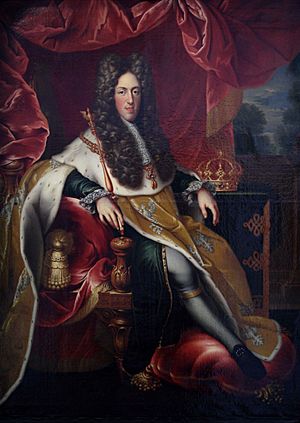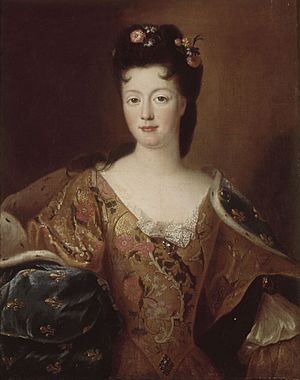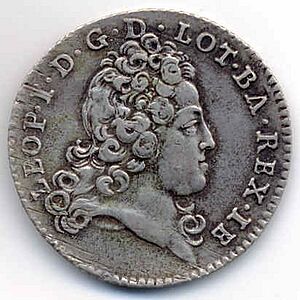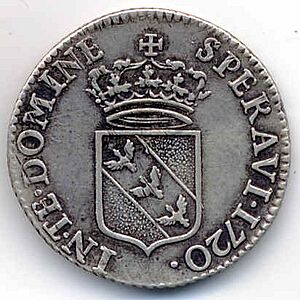Leopold, Duke of Lorraine facts for kids
Quick facts for kids Leopold |
|
|---|---|
 |
|
| Duke of Lorraine and Bar | |
| Reign | 18 April 1690 - 27 March 1729 |
| Predecessor | Charles V |
| Successor | Francis III Stephen |
| Born | 11 September 1679 Palace of Innsbruck, Tyrol, Archduchy of Austria, Holy Roman Empire (now in Austria) |
| Died | 27 March 1729 (aged 49) Château de Lunéville Lorraine, Duchy of Lorraine (now in France) |
| Burial | Church of Saint-François-des-Cordeliers, Nancy, France |
| Spouse | Élisabeth Charlotte d'Orléans |
| Issue Detail |
|
| House | Lorraine |
| Father | Charles V, Duke of Lorraine |
| Mother | Eleanor of Austria |
| Religion | Roman Catholicism |
Leopold the Good (born September 11, 1679 – died March 27, 1729) was the Duke of Lorraine and Bar. He ruled from 1690 until his death. Through his son, Francis Stephen, Leopold became the direct ancestor of all the rulers from the Habsburg-Lorraine family. This includes all the Emperors of Austria.
Contents
Leopold's Early Life and Education
Leopold Joseph Charles Dominique Agapet Hyacinthe was the son of Charles V, Duke of Lorraine. His mother was Eleonora Maria Josefa of Austria, who was the half-sister of Leopold I, Holy Roman Emperor.
When Leopold was born, his lands, Lorraine and Bar, were taken over by Louis XIV of France. This forced his parents to live away from home in Austria. They were protected by the Emperor. Because of this, Leopold was born in the palace of Innsbruck. He was named after the Emperor. Leopold grew up in Innsbruck while his father was busy defending Vienna from the Turks.
In 1690, Leopold's father passed away. Eleven-year-old Leopold then inherited the Duchies, which were still occupied. His mother wanted to fulfill her husband's last wish: to get their children's homeland back. She asked the German parliament in Regensburg to return Lorraine to her son. Leopold was sent to Vienna to get military training under the Emperor's guidance. In Vienna, he grew up with his cousins, Joseph and Charles, who both later became Emperors. Leopold also received a special award called the Knight of the Order of the Golden Fleece that year.
Like his father, Leopold joined the Emperor's army. At eighteen, he fought in a battle at Timișoara in 1694. Three years later, he became the leader of the Army of the Rhine.
Leopold Becomes Duke of Lorraine
On October 30, 1697, a major conflict called the Nine Years' War ended. It was also known as the War of the League of Augsburg. This war ended with the signing of the Treaty of Ryswick.
This treaty gave the duchies of Lorraine and Bar back to the House of Lorraine. This was exactly what Leopold's mother had hoped for. She passed away four days later in Vienna. On August 17, 1698, Duke Leopold made a grand entry into his capital city, Nancy. He worked hard to rebuild and repopulate his land, which had been damaged by war. He encouraged people to move there. By the end of his rule, the duchy was safe and successful.

In his foreign policy, Leopold tried to have good relations with France. He wanted to keep his powerful neighbor happy. On October 13, 1698, at the Palace of Fontainebleau, Leopold married Élisabeth Charlotte d'Orléans. She was the niece of King Louis XIV of France. The King gave a large sum of money, 900,000 livres, to the Duke, who didn't have much money. Élisabeth Charlotte was a caring mother. She gave birth to fourteen children, but only five of them lived to be adults. Three of their children died within a week in May 1711. This happened because of a smallpox outbreak at the Château de Lunéville, which was the country home of the dukes of Lorraine.
Even with Leopold's efforts to keep peace, his capital, Nancy, was taken over by foreign troops. This happened during the War of the Spanish Succession (1700–1713). Leopold worried about his family. So, he moved his royal household to the Château de Lunéville. Leopold rebuilt this castle to be as grand as the "Versailles of Lorraine." His first child, also named Leopold, was born there in 1700.
In 1703, the Duke introduced new laws for his land called the Code Léopold. He also tried to make his eldest daughter, Élisabeth Charlotte Gabrièle of Lorraine, a leader of the Remiremont monastery. However, he failed because Pope Clement XI disagreed.
Later Years and Family
In 1708, Leopold said he should get another land called the Duchy of Montferrat. He was the closest relative to its ruler, Charles III Gonzaga. Charles had been removed from power and died without any sons. However, the Emperor had already promised Montferrat to the Dukes of Savoy. To make up for this, the Emperor gave the Duchy of Teschen in Silesia to Leopold.
In 1710, Leopold and his wife visited Paris. They attended the wedding of Élisabeth Charlotte's niece, Marie Louise Élisabeth d'Orléans, to the Duke of Berry. They were guests at a fancy dinner at the Palais du Luxembourg. During this visit, Leopold was given the special title of Royal Highness because he was a foreign prince.
In 1719, Leopold bought the County of Ligny-en-Barrois from his cousin, Charles Henry of Vaudemont. During his rule, a new security system was set up all around Lorraine. He tried to end serfdom, which was a system where peasants were tied to the land. But the payments needed to free them were too high for the farmers. Leopold even cut the payments in half, but it was still too much. On New Year's Eve in 1719, he freed his own serfs without any payment. He hoped that the nobility (rich landowners) would follow his example, but they did not.
In 1721, Leopold arranged for his son and heir, Leopold Clement, to study in Vienna. He also wanted to create ties with Archduchess Maria Theresa. She was the future ruler of Emperor Charles VI's lands. However, Leopold Clement died soon after at Lunéville. So, his younger son, Francis Stephen, went to Vienna instead. There, he married Maria Theresa. Francis later became Emperor. His descendants, the House of Habsburg-Lorraine, ruled Austria until 1918.
In 1725, Leopold tried to arrange for his daughter, Anne Charlotte, to marry the young King Louis XV. But Louis Henry, Duke of Bourbon, who was then the prime minister, stopped this marriage. He didn't want a union with a descendant of the rival House of Orléans. Then, Élisabeth Charlotte tried to arrange her daughter's marriage to her first cousin, Louis, Duke of Orléans, who had recently lost his wife. But Louis refused. Since all marriage proposals were ignored or turned down, Anne Charlotte later became the abbess (leader) of the monasteries in Remiremont and Essen.
In March 1729, Leopold caught a fever while walking at the Château at Ménil, near Lunéville. He returned to Lunéville, where he passed away on March 27. He was 49 years old.
Leopold's Children
Leopold and Élisabeth Charlotte had 14 children:
- Léopold (August 26, 1699 - April 2, 1700)
- Élisabeth Charlotte (October 21, 1700 - May 4, 1711)
- Louise Christine (November 13, 1701 - November 18, 1701)
- Marie Gabrièle Charlotte (December 30, 1702 - May 11, 1711)
- Louis (January 28, 1704 - May 10, 1711)
- Josepha Gabrièle (February 16, 1705 - March 25, 1708)
- Gabrièle Louise (March 4, 1706 - June 13, 1710)
- Léopold Clement Charles (April 25, 1707 - June 4, 1723)
- Francis Stephen (December 8, 1708 - August 18, 1765), his successor. He married Maria Theresa of Austria and became Holy Roman Emperor.
- Eléonore (June 4, 1710 - July 28, 1710)
- Elisabeth Therese (October 15, 1711 - July 3, 1741). She married Charles Emmanuel III of Sardinia in 1737.
- Charles Alexander Emmanuel (December 12, 1712 - July 4, 1780). He was a governor and army commander.
- Anne Charlotte (1714 - 1773). She became an abbess at Essen.
- Stillborn daughter (November 28, 1718).
See also
 In Spanish: Leopoldo I de Lorena para niños
In Spanish: Leopoldo I de Lorena para niños



